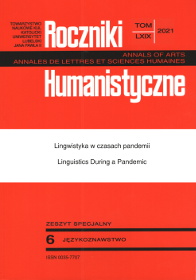Dodawać otuchy w czasach pandemii. Strategie dyskursywno-interakcyjne wykorzystywane w komentarzach do wypowiedzi chorych na Covid-19
Abstrakt
Przedmiotem artykułu są strategie dyskursywno-interakcyjne, do których odwołują się hiszpańskojęzyczni użytkownicy serwisu YouTube w komentarzach kierowanych do chorych na COVID-19. W sposób szczególny interesują nas mechanizmy, przy pomocy których wyrażane jest wsparcie i solidarność. Wychodzimy z założenia, iż komentarze pozostawiane pod filmikami umieszczanymi w Youtube stanowią szczególny rodzaj komunikacji, która nie będąc prototypową realizacją zasady interakcyjnej wzajemności wykazuje znaczny stopień interpersonalnego i interakcyjnego oddziaływania. Wydzielone strategie (a wśród nich życzenia, nacechowane ekspresywnie formy wołaczowe, werbalne sygnały empatii i zainteresowania, komplementy i pochwały, inwokacje o charakterze religijnym itp.,) wydają się wskazywać, iż pandemiczna rzeczywistość przyczyniła się do wytworzenia sowitego rodzaju wirtualnej community of practice, która we właściwy sobie sposób realizuje interakcyjnie pojmowaną zasadę solidarności, wartościując przy tym czas naznaczony epidemią koronawirusa.
Bibliografia
Austin, John L. How To Do Things With Words. Clarendon Press, 1962.
Blanco, Xavier. «Les pragmatèmes: définition, typologie et traitement lexicographique». Verbum, vol. 4, 2013, págs. 17-25.
Bucholtz, Mary y Kira Hall. «Identity and interaction: a social-cultural linguistic approach.» Discourse Studies, vol. 7, N.° 4-5, 2005, págs. 585-614.
Carretero, Marta, Carmen Maíz-Arévalo y María-Ángeles Martínez. «‘Hope This Helps!’ An analysis of expressive speech acts in online task-oriented interaction by university students». Yearbook of Corpus Linguistics and Pragmatics, ed. Jesús Romero-Trillo, Springer International Publishing, 2014, págs. 261-289.
Chamorro Maldonado, Miguel Alejandro. «El conflicto catalán: discursos de los medios y expresiones discursivas de los usuarios en Youtube». Comunifé: Revista de Comunicación Social, vol. 18, N.° 18, 2018, págs. 65-75.
Dumitrescu, Domnita. «La expresión de buenos deseos hacia nuestro prójimo: ¿un acto de habla cortés automático?» Pragmática sociocultural: estudios sobre el discurso de cortesía en español, ed. Diana Bravo, Antonio Briz, Ariel, 2004, págs. 265-283.
Eckert, Penelope y Sally McConell-Ginet. «Communities of practice: Where language, gender, and power all live». Locating Power: Proceedings of the Second Berkeley Women and Language Conference, ed. Kira Hall y Mary Bucholtz, Berkeley Women and Language Group, 1992, págs. 89-99.
Gallardo Camacho, Jorge. «Análisis del fenómeno Yotube en España: Relación con los espectadores y los generadores de contenidos tradicionales». Revista Luciérnaga, vol. 5, N.° 9, 2013, págs. 57-68.
García González, Lidia A. «Aproximaciones al estudio del movimiento social #YoSoy132 a través del análisis de los cometarios de videos en YouTube». Versión. Estudios de Comunicación y Política, N.° 31, 2013, págs. 79-89.
Gharbi, Najwa. «Les pragmatèmes d’affect: délimitation définitoires et propriétés sémantico-pragmatiques». Lublin Studies in Modern Languages and Literature, vol. 42, N.° 4, 2018, págs. 150-170.
Haverkate, Henk. La cortesía verbal. Estudio paragmalingüístico. Gredos, 1994.
Katsiki, Stavroula. Les actes de langage dans une perspective interculturelle: L’exemple du vœu en français et en grec, Tesis doctoral inédita, Université Lumière Lyon 2, 2001.
Martin, James Robert, y Peter R. White. The language of Evaluation. Appraisal in English. Palgrave Macmillian, 2005.
Orduña-Malea, Enrique, Cristina I. Font-Julián y José-Antonio Ontalba- Ruipérez. «Covid-19: análisis métrico de vídeos y canales de comunicación en YouTube». El profesional de la información, vol. 29, N.° 4, 2020, págs. 1-14.
Peláez Torres, Marta. «Aproximación sociopragmática y pragmalingüística a la formulación de buenos deseos y felicitaciones en español». Pragmalingüística, N.° 25, 2017, págs. 467-489.
Sánchez-Olmos, Cande y Tamara Hidalgo-Marí. «Del sofá a YouTube: estudio de género sobre la interacción en la red social en torno a las series de TV españolas». Communication & Society, N.° 29 (2), 2016, págs. 117-132.
Copyright (c) 2021 Roczniki Humanistyczne

Utwór dostępny jest na licencji Creative Commons Uznanie autorstwa – Użycie niekomercyjne – Bez utworów zależnych 4.0 Międzynarodowe.





